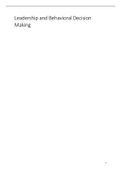Summary
Summary Leadership and Behavioral Decision Making Master Business Administration
- Course
- Institution
Full summary of all classes Leadership and Behavioral Decision Making given by prof Lieven Brebels and prof Nicolas Bastardoz in academic year . Passed during first examination period.
[Show more]



